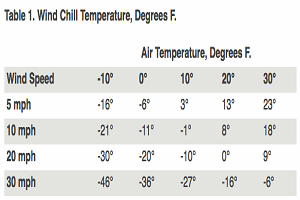Most beef producers understand that when the weather gets colder their cattle need more energy for maintenance. So at what temperature do cattle actually begin experiencing cold stress and then how much more energy do they need?
The answer takes a couple of factors into consideration, explained Warren Rusche, SDSU Extension Beef Feedlot Management Associate. "The actual temperature and wind speed interact to determine the effective temperature," Rusche said.
He referenced Table 1 which shows the dramatic effect wind speed has on the effective temperature the cattle experience.
"Based on what we know about wind's impact on effective temperature - goes to show that any kind of available protection, whether natural or man-made, can be very valuable in reducing wind chill and the negative effects of cold environments," he said.
When do cattle begin to feel cold stress?
The point of cold stress or lower critical temperature, depends in large part on the amount of insulation provided by the hair coat.
Referencing Table 2, Rusche showed that insulation value changes depending on the thickness of the haircoat and whether it is dry or wet.
"As a general rule, for every degree that the effective temperature is below the lower critical temperature, the cattle's energy needs increase by 1 percent," Rusche said.
For instance, if the effective temperature is 17 degrees Fahrenheit, the energy needs of a cow with a dry winter coat are about 15 percent higher than they would be under more moderate conditions.
That energy requirement jumps up to about 40 percent higher under those conditions if the hair coat is completely wet or matted down with mud.
"It's important to remember that cattle can adapt to short term weather changes relatively well without a significant impact on performance," Rusche said.
He explained that cattle can deal with a few cold, miserable days without suffering long-term effects. However, ignoring the energy costs of long-term cold stress greatly increases the risk of poor performance later.
Muddy conditions in a feedlot are especially detrimental to performance.
"Any steps that can reduce cold stress, such as providing wind protection or bedding will reduce maintenance requirements and maintain performance," he said.
For additional information on the use of bedding in a feedlot, visit iGrow.org and search for the article titled, Bedding During Winter Months Pays Off.
Feed in-take
Although beef cows fed high-roughage diets often respond to cold stress by increasing voluntary feed intake, the same is not necessarily true for feedlot cattle being fed high-concentrate diets. "Especially if cattle must contend with poor lot conditions due to mud, ice, or snow," Rusche said.
There are some management considerations to keep in mind regarding changes in feed intake in response to cold stress:
- Make sure that water is available. Feed intake will be reduced if water availability is restricted for any reason such as frozen water lines or slippery footing near waterers.
- If the feed availability is limited either by snow cover or access to hay feeders, the cattle may not have the opportunity to eat as much as their appetite would dictate.
- Be careful providing larger amounts of high concentrate feeds. Rapid diet changes could cause significant digestive upsets.

Click here to see more...